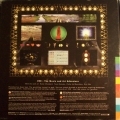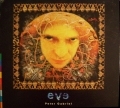EVE
First posted on 01 May 2011. Last updated on 01 May 2011.
"My name is Helen Chadwick. I am an artist. I make things. Some people like them, some don't."
The artist introduces herself in a scene from the game, not only explaining her approach to art but also the best way to approach this title. It is art. It has things. Some people will like them, and some will not. The truth, though, is that most who try out this multimedia title will probably experience the former rather than the latter. Delightful, intelligent, and moving, EVE (also known as EVE: Peter Gabriel and EVE: The Music and Art Adventure) is an experience you have, not a game you beat.
EVE, released by Real World Multimedia in 1996, follows the success of its predecessor, XPLORA 1: Peter Gabriel's Secret World, which it easily surpasses. The time and effort invested in the production of EVE is clearly evident. The game features 45 minutes of music and 80 minutes of video and involves about 60 notable contributors as well as Peter Gabriel himself. The inside of the game's packaging has a faux velvet finish and comes with a beautifully designed soft cover book, featuring art and interesting essays from artists highlighted in the game. The game does not look its age, except that the installation uses an older version of Apple QuickTime on the disc that may or may not be compatible with newer operating systems. The sound and image quality is good, but the resolution is limited to only 640x480 pixels. The game has about 160 screens. It is painful to imagine how these screens may look in high definition, but the joy of seeing them outweighs that.
Familiarity with Gabriel and his work is not a requirement to play this game. The center of the game lies in the artwork of 4 modern artists and the issues and ideas that they explore. The music plays a supporting but omnipresent role in an unbelievable array of samples and loops. Having used and experimented with digital recording methods since the early 1980s, there are plenty of sounds available, far beyond his released albums.
Each world of the game is themed to a particular artist paired with a song. In order, they are Yayoi Kusama with Come Talk to Me in the Mud world, Helen Chadwick with Shaking the Tree in the Garden world, Cathy de Monchaux with In Your Eyes in the Profit world, and Nils-Udo with various pieces from Passion (Gabriel's score for Martin Scorsese's The Last Temptation of Christ) in the Paradise world. Each of them physically evolves into the next on the main world screen, which is a letterboxed panoramic landscape that you can scroll in any direction.
The story of the game loosely follows Adam and Eve, who have been separated in the Garden of Eden at the start and must now find one another. There is some suggestion that you are playing as Adam and Peter searching for Eve, hence the title, but this is not obvious. The biblical story is only a tenuous theme, as the true story is about you, the player, and your journey as you learn about human relationship and its meaning. It may be pretentious to call EVE either high art or scholarly, but for a video game it is probably the closest any have come.
Despite any bohemian aspirations, the game is still a proper adventure and is made up of plenty of puzzles. You find objects, open new areas, and figure out what to do next. Experienced players will find the game to be both familiar and simple. However, EVE is also different from other adventure games in many ways. In a topiary garden, for example, if you give coffee to a gardener, he will exchange his clippers and take a break, allowing you to cut through the hedges and reveal hidden secrets. In another puzzle, you smash lawn gnomes against rocks to find hidden objects. In all cases, play takes precedence over peril, and the challenges are wholly appropriate for the spirit of the game regardless of skill level.
The cursor changes from blue to yellow when a hotspot is touched. There is no score to keep, and there are no penalties for asking for help. Right clicking the mouse brings up a help menu and a number assigned to the scene. The number can be looked up in a hint file for clues. The hints are not numbered in order, so the file cannot be read from start to finish to quickly march through the game.
Each screen will only allow about 3 actions before closing off the puzzle and requiring you to go to another area. This may seem tedious at first, but it prevents you from spending too much time on any single screen and obsessively forcing yourself into boredom. The limit encourages you to move on, even though returning to the previous screens only takes a few clicks. You move from screen to screen by clicking on objects that represent other screens. It is not always obvious what will lead where, but navigation is fairly simple.
Apart from the sonic ambience, Gabriel's music appears in the form of musical toys. Puzzles hide sound clips and loops that can be used to make remixes in the Interactive Music Xperience rooms (IMX). Each world has only a single song, but thanks to Gabriel's studio experimentation and live performances, each song is spread out in a rich landscape of sound, art, and animation. This element of the game is unique and keeps the gameplay interesting long after the end. Remixes can be saved, loaded, and shared later.
Not all of the puzzles in EVE are easy. In a particular screen, for example, you need to search though grass with a magnifying glass to find bugs that represent sounds for the "Shaking the Tree" IMX. This pixel hunt is quite tedious and probably the hardest puzzle in the game, although getting all the sounds for the song is motivating enough even when it is not required to finish the game. Any game can truly be called fun when there is another reason to continue playing besides conquest.
You also collect sound clips from various "Experts", who then make them available in the Theme Rooms in which they deliver miniature lectures. Each Theme Room includes that world's artist and Gabriel, as well as other professionals who can contribute to discussions on humanity. For example, writer Kathy Acker remarks that women may be more aware of mortality than men because they menstruate, and psychologist Robin Skynner believes communication is so important that "it's much better for people to argue than withdraw".
Besides experts, you also hear from average folks. The Human Relationships Room, present from the beginning to the end of the game, has short videos of anonymous British interviewees answering questions that you never hear. As the game progresses, the answers follow certain themes, such as attraction or rejection. For example, an interviewee admits that "I believe in attraction at first sight", while another recalls the hurtful experience of falling in love.
Many of these sound bites include very frank talk about sexuality, a common theme in EVE. This is evident from the very start of the game, as both Adam and Eve are completely nude, though the content is rated with various suggested ages for different countries. There is much sexual content, but none of it is pornographic. The sexual imagery is not meant for excitement, but instead invites you to ask yourself questions about those emotions and what they mean to you.
EVE is a truly unique gaming experience. It manages to use not only visuals and sounds but also the apparatus of interactivity itself to convey meaning. In some ways, EVE does not ever end. There are always reasons to return, and even if you do not, there will be at least an image or idea that will always remain inside you. At some point in the game, there is a puzzle which, if solved, prevents disaster. However, failing to solve it actually grants you access to another extra world. Failure is thus rewarded, but this is no mistake. In most games, winning means never failing. However, true to the self actualization theme of EVE, loss is a necessary part of growing. Using gameplay to illustrate such a complicated human concept is a feat that few other interactive titles can do better.






